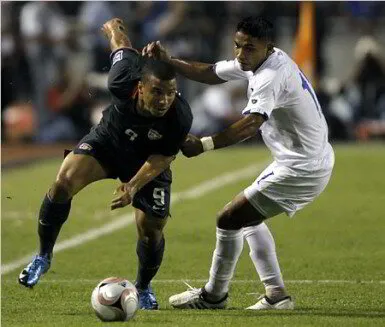Many of you probably saw a few of the games of the past World Cup this summer. As I was watching the Cup this past month a few thoughts popped into my head. I should've posted on this earlier in the summer during the actual play of the World Cup but due to the College World Series and a few other things I didn't get to it until now.
Everyone always wants to train soccer with loads and loads of running. It's not uncommon for coaches to implement 2 mile runs, 3 mile runs, repeat 300 yard shuttles, etc. for soccer athletes. After all they run non-stop all the time for their sport. . . right?
If anybody truly watched the Cup with a critical eye as a sport performance coach you would have noticed that the athletes aren't running all that much. Now I know somebody is going to blow my words out of proportion and be all over me for that statement but hear me out on this one.
When you watch what most of the athletes are doing during play, the general majority of them are in a walk or very slow recovery jog. The ones playing the ball are working, but the vast majority of team sits back somewhat. They aren't continuously running around in circles or up and down the field like I think a lot of coaches believe. This is especially true when the ball is in the middle of the field. The majority of the athletes are in a walk or slow jog.
I wanted to post a few videos of play during the World Cup to illustrate what I was talking about but they aren't that easy to come by. Most of the videos only show goals so it isn't a great example but you still see what I'm talking about in a few of the shots, but if you actually watch the athletes that aren't around the ball you can see the type of recovery they get.
Soccer isn't a continuous 3 mile run like coaches repeatedly try to train it. It bouts of high intensity sprints (cutting, acceleration, deceleration) combined with bouts of low intensity recoveries. When we look at the total of running volume in a match we find that the high intensity volumes actually make up a small percentage of the total volume of movement that occurs. What we also find is that the vast majority of the volume is at a walk or slow jog emphasizing recovery. They don't continuously sprint either, such as a 300 yard shuttle. The majority of sprints in a match are 10-20 yards with bouts of recovery.
According to Withers et al., (1982) 26.3% of total play time is made up of phases of walk, 64.6% of slow jog, 18.9% of quick runs and sprints, and 1.1% of phases of possession of the ball. In (1985) Mayhew and Wenger established that during his game a soccer player walks 46.6%, runs slowly 38%, runs quickly or sprints 11.3% and stands without moving 2.3% of total playing time.
If this is the case why do coaches train soccer players in a lactic environment as such with 300 yard shuttles, or continuous runs as in a 2, or 3 mile jogs. Shouldn't athletes utilize short bouts of high intensity sprints followed by recovery walks, slow jogs, etc. Soccer athletes are rarely in a lactic environment, and when it happens it is for a very short time. Coaches shouldn't waste time training the glycolytic energy system to a high degree when they can achieve the results of increased lactate threshold with lower intensity aerobic work, and high intensity sprints, agility movements, etc.
The following link is a great resource for anyone training soccer athletes. It gives great insight into the energy system demands that are required during a 90-minute bout on the pitch.
This statement from the above article summarizes the sport of soccer and what is truly required as far as aerobic / alactic requirements.
Soccer requires intermittent physical activity in which sequences of actions requiring a variety of skills of varying intensities are strung together (Cometti et al., 2001). The exercise pattern is characterized by repeated short duration bouts of high intensity exercise interspersed with longer periods of lower intensity exercise and passive recovery (Balsom et al., 2001). Although the total duration of high intensity exercise performed during a multiple sprint sport only accounts for a very small proportion of the total game time, such periods are most often instrumental in determining the outcome of the game. Many activities in soccer require forceful and explosive bursts of energy including tackling, jumping, kicking, turning and changing pace. The power output during such activities is critical in determining the overall success of performance (Strudwick et al, 2002). In order to cope with the physical requirements for elite soccer match-play, it is important that the players have a high level of speed, agility, muscular strength and anaerobic power.
The quality that truly separates soccer athletes is acceleration in sprinting. An article I posted a few weeks ago on the AJAX Academy in Europe states that 10-20 meter acceleration is the most important quality that an athlete can possess.
European Model of Sport Selection – GREAT READ
In all this I'm not saying that soccer athletes don't need high levels of aerobic endurance because they do. A highly developed aerobic system will help to buffer lactic acid at a higher rate, and emphasize the ability for athletes to recover faster in between high intensity bouts of sprints, and cutting. What I am saying is that coaches should look at their sport critically and truly determine what energy systems are required and at what dosage and not just assign random conditioning drills because that's what others do.



